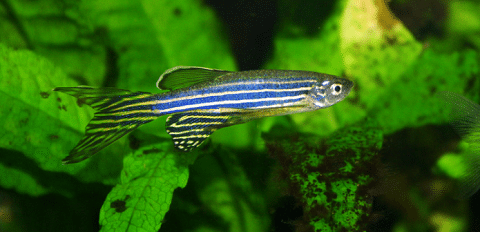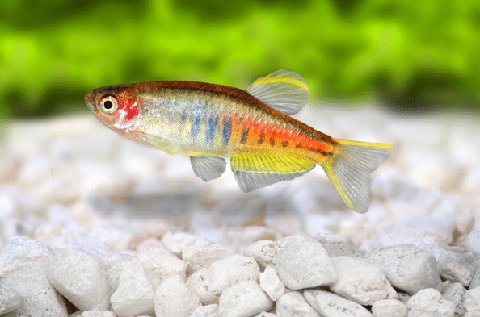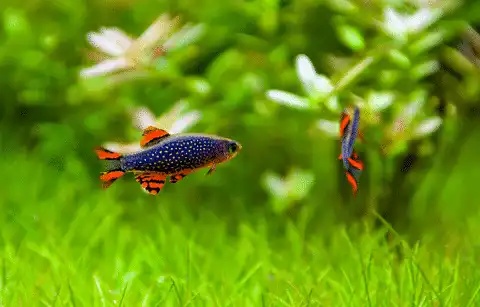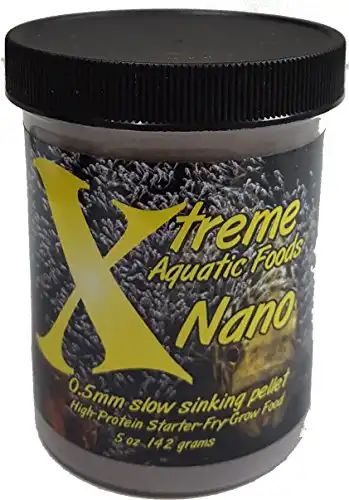Thank you for visiting! By the way… any links on this page that lead to products on Amazon and other stores/partners are affiliate links Aquarium Store Depot earns a commission if you make a purchase.
Are you looking for some new fish to add to your tank? Danio fish are a great option – there are several different types, and they come in a variety of colors. In this blog post, we’ll take a closer look at the different types of danios, as well as provide pictures (and videos) so you can see what they look like. So read on to learn more about these interesting fish!
What Are Danio Fish?
Danio fish are some of the most important fish in the aquarium hobby as well as in the scientific world. The most popular species of danio to come across is the common danio (Danio rerio), also known as zebrafish. However, the genus of Danio contains almost 30 different species with 9 of them making their way into the homes of freshwater enthusiasts!
Danio fish are considered to be some of the easiest fish to keep in the home aquarium. Their hardiness and quick reproduction rates have also made them the perfect candidate for use as a model organism for gene sequencing. Specifically, Danio rerio has been used to study drug development, regenerative properties, and other bioengineering practices.
Some of these studies have been taken advantage of by the aquarium industry, creating fluorescent varieties of danio called GloFish. These fish have been genetically prioritized to express neon colors of red, green, yellow, and more. Once these genes are expressed, they will continue to be passed onto later generations of danio, meaning that there is no cruel practice involved. Sadly though, there are many breeders that dye their fish for brighter and more appealing colorations.
Top 9 Types of Danios Best Suited For Aquariums
In the freshwater aquarium hobby, danios are seen as beginner fish. They don’t require a lot of room to thrive and can bring a ton of activity to the top portions of the tank. Though common zebra danios are the most popular fish species available, there are actually 8 other varieties that can bring new life to a tropical setup.
We have a video just for you from our Aquarium Store Depot YouTube Channel. We go into more detail in our blow post below. If you enjoy our content, please subscribe as we post new videos each week! Let’s start with the first on the list!
1. Celestial Pearl Danio
A great-looking danio fish. Males are more colorful than females. A midway dwelling fish
- Scientific Name: Danio margaritatus
- Difficulty Level: Moderate
- Temperament: Peaceful
- Adult Fish Size: 1 inch
- Minimum Tank Size: 10 gallons
- Diet: Omnivorous
- Origin: Burma
- Temperature: 65-80°F
- pH: 6.5-7.5
- Difficulty to breed: Moderate
- Planted tank suitability: Common
Sometimes wrongly referred to as galaxy rasboras, celestial pearl danios belong to the Danio genus along with the other fish species on this list. These fish are a recent addition to the aquarium hobby, almost causing them to become endangered shortly after their discovery in 2006. Their spotted trout-like appearance has made them a favorite, yet expensive, staple to the planted aquarium.
Celestial pearl danios come from very specific ecosystems at high altitudes in Hopong, Burma. They can be found in large groups, which needs to be replicated in the aquarium setting by keeping at least 6 members at all times; ideally, these fish should be kept in large groups starting with 20 individuals.
Celestial pearl danios can be slightly more challenging to keep as they are not very hardy fish and succumb to imperfect or irregular water conditions. They also do better in cooler water temperatures, making them incompatible with other species.
2. Zebra Danios

- Scientific Name: Danio rerio
- Difficulty Level: Easy
- Temperament: Peaceful
- Adult Fish Size: 3 inches
- Minimum Tank Size: 10 gallons
- Diet: Omnivorous
- Origin: Pakistan, India, Bangladesh, Nepal, and Myanmar
- Temperature: 64-75°F
- pH: 6.5-7.5
- Difficulty to breed: Easy
- Planted tank suitability: Common
Zebra danios are arguably the most popular and available fish on this list. These are incredibly active fish that earn their name from the horizontal black and yellowish-silver stripes that run from their heads to their tails.
In the wild, the Zebra danio fish are found in a wide range of ecosystems from stagnant waters to fast-moving mountain streams. Most of these environments have cooler water temperatures than typical tropical fish, which will need to be replicated in the aquarium.
The zebra danio is a schooling fish and will need to be kept in groups of at least 6 or more. Due to their activity and tendency to stay towards the top of the tank, schools can quickly become overwhelming for other fish as well as for other danios. Because of this, it’s recommended to keep smaller schools with other species that stay toward the bottom of the aquarium.
3. Gold Longfin Danio
- Scientific Name: Danio rerio
- Difficulty Level: Easy
- Temperament: Peaceful
- Adult Size: 3 inches
- Minimum Tank Size: 10 gallons
- Diet: Omnivorous
- Origin: India
- Temperature: 64-75°F
- pH: 6.5-7.5
- Difficulty to breed: Easy
- Planted tank suitability: Common
The gold longfin danio (video source) is a more colorful variation of the common Danio rerio. These types of danios naturally occur in the Ganges region in Eastern India, though the aquarium hobby has enhanced their coloration and finnage.
The gold longfin danio is named after its bright yellow body with white stripes. Compared to other species, they also have noticeably longer fins. In terms of care requirements, they have the same needs as regular Danio rerio fish.
4. Gold Ring Burmese Danio
A golden-colored Danio Fish that only grows to 1.5 inches. A highly adaptable fish
- Scientific Name: Danio tinwini
- Difficulty Level: Easy
- Temperament: Peaceful
- Adult Size: 2 inches
- Minimum Tank Size: 10 gallons
- Diet: Omnivorous
- Origin: Myanmar
- Temperature: 64-75°F
- pH: 6.5-7.5
- Difficulty to breed: Easy
- Planted tank suitability: Common
Though similar in name to the gold longfin danio, the gold ring Burmese danio (video source) is a species all of its own. Instead, these unique fish are named after the leopard-like black spots that cover their pale yellow body. They are especially identifiable by their opaque white abdomen.
Gold ring danios have the same behaviors and care requirements as zebra danios, but are slightly smaller. Though an inch difference might not seem like a lot, these fish are that much more susceptible to bullying and strong water currents. Still, the best tank mates for gold ring danios will be other types of danio and slow-moving fish species.
5. Glowlight Danio

- Scientific Name: Celestichthys choprae
- Difficulty Level: Easy
- Temperament: Peaceful
- Adult Size: 1.5 inches
- Minimum Tank Size: 10 gallons
- Diet: Omnivorous
- Origin: Myanmar
- Temperature: 64-75°F
- pH: 6.5-7.5
- Difficulty to breed: Easy
- Planted tank suitability: Common
Not to be confused with GloFish danios, glowlight danios are very unique fish. They’re not even true danios and belong to the Celestichthys genus instead!
These fish are extremely colorful with a yellow-based body with vertical blue stripes and a pink stripe leading to their tail. They are also much smaller than the other types of danios on this list, but one of the more expensive varieties.
Glowlight danios are very tight schoolers and will thrive in large groups. They are more likely to venture to lower portions of the other tank than other species, so it’s important to keep their activity levels in mind when stocking.
6. Pearl Danio
- Scientific Name: Brachydanio albolineatus
- Difficulty Level: Easy
- Temperament: Peaceful
- Adult Size: 2 inches
- Minimum Tank Size: 10 gallons
- Diet: Omnivorous
- Origin: Myanmar, Sumatra
- Temperature: 73-77°F
- pH: 6.5-7.5
- Difficulty to breed: Easy
- Planted tank suitability: Common
The pearl danio, also known as the blue danio or turquoise danio, is a plain iridescent fish. While they may not be the most colorful species on this list, their simplicity catches the eye in a well-planted aquarium.
Pearl danios have the same care requirements and behaviors as other danios and will do best when kept in small groups. It is important to note that pearl danios need a slightly higher water temperatures than other types of danios that can tolerate cold climates.
7. Leopard Danio

- Scientific Name: Danio frankei
- Difficulty Level: Easy
- Temperament: Peaceful
- Adult Size: 3 inches
- Minimum Tank Size: 10 gallons
- Diet: Omnivorous
- Origin: India
- Temperature: 64-75°F
- pH: 6.5-7.5
- Difficulty to breed: Easy
- Planted tank suitability: Common
The leopard danio is very close in appearance to the gold ring Burmese danio, though they’re not related. Leopard danios have slightly more streamlined bodies and much smaller bluish-black spots on a light yellow body. Some of these spots transfer onto the fins.
Unlike other danios, the leopard danio fish occurs in slow-moving or stagnant waters. However, they appreciate some water flow in the aquarium setting. Like the others, they appreciate being in small groups in vegetative setups.
8. Giant Danio

- Scientific Name: Danio aequipinnatus
- Difficulty Level: Easy
- Temperament: Peaceful
- Adult Size: 4 inches
- Minimum Tank Size: 30 gallons
- Diet: Omnivorous
- Origin: India, Nepal
- Temperature: 72-75°F
- pH: 6.0-7.0
- Difficulty to breed: Easy
- Planted tank suitability: Common
Though called giants, giant danios are only about an inch bigger than other species of this fish. However, this potential size is enough to make their minimum tank size a little bigger than the others to allow for growing room and space to swim. They also prefer slightly warmer water temperatures and a lower pH.
These aquarium fish are plain in color, but beautiful upon a closer look. They have pale bodies with highlights of light blue. Paired with their activity level, they can create contrast against a planted background in a large group.
9. GloFish Danio
- Scientific Name: Danio rerio
- Difficulty Level: Easy
- Temperament: Peaceful
- Adult Size: 2.5 inches
- Minimum Tank Size: 10 gallons
- Diet: Omnivorous
- Origin: Captive-bred
- Temperature: 64-75°F
- pH: 6.5-7.5
- Difficulty to breed: Not permissible
- Planted tank suitability: Common
GloFish are highly fluorescent types of danio. This trait has been inherited through the generations and patented by the GloFish company, making it illegal to breed them. However, they are widely available in most aquarium stores and can make a fun and unique addition to a blacklight freshwater setup.
It is important to purchase only GloFish (certified danio fish as others could be cruelly dyed with artificial colors. GloFish danio colors include Starfire Red®, Electric Green®, Sunburst Orange®, Cosmic Blue®, and Galactic Purple®.
Danio Tank Setup
The best thing about danios is that they will thrive in most tank setups, anything from a simple 10 gallon tank with colorful decorations to a 100 gallon system with the rarest freshwater plants. As long as water parameters stay stable and in their preferred range, these fish will thrive.
Substrate & Decorations
Danio fish can be kept on gravel or sand. They do not regularly venture towards the bottom of the tank, which nearly eliminates the threat of long fins getting tugged or bodies getting scratched. If you find that your fish is laying towards the bottom of the aquarium, check water parameters immediately as this could be a sign that something is wrong.
Otherwise, danios do not need an elaborate setup. They will do well in a barebones aquarium with simple decorations. If you really want to treat your fish though, provide easy floating plants that they can pick at for food and hide in at the surface of the water.
A fully planted setup will make these simple and peaceful fish shine even more.
Lighting & Filtration
Lighting will largely depend on the types of plants being kept in the aquarium. Danios do not need any specific lighting, though GloFish will glow best under a blacklight; don’t be tricked into buying a special aquarium blacklight as any one will work.
An important thing to remember is that these fish stay towards the top of the aquarium. If using a high-intensity light for red and foreground plants, make sure to provide your fish with some coverage that they can escape to if the light becomes too much.
Though danios aren’t the messiest fish, they can start to create large amounts of waste when kept in big groups. It is always recommended to have a filter that is rated for at least twice the size of the aquarium, with bigger being better. In most cases, you can’t overdo good filtration for danios as they’ll appreciate the extra water flow. A simple power filter should do the trick for a danio tank.
The Best Aquarium Power Filter
The worlds best selling and most reliable power filter on the market. Unchanged for years because it's so reliable and versatile
Heating
Danio fish are considered a coldwater species. They can tolerate significantly colder water temperatures than typical tropical fish. However, most of these fish have been bred in the aquarium industry and have acclimated to average water conditions.
When buying your danio, it is best to ask what temperature they are being kept at and match those parameters.
Do Danios Need A Heater?
Being a coldwater fish, danios do not necessarily need a heater. If ambient room temperature constantly stays in the same range as the preferred one of your danio, then you don’t need a heater.
However, a heater is always recommended for any tank setup. This is because temperatures can easily fluctuate throughout the day enough to cause stress on your fish. For that reason, danios should always have a heater to keep temperatures constant rather than to raise the temperature.
How To Care For Danio Fish
Danio care is simple and straightfoward. Once the tank is cycled and the fish are safely acclimated, there’s little to worry about going wrong. The biggest concern will be keeping these active aquarium fish fed and choosing the right tank mates.
Aquarium Maintenance
Danio aquarium maintenance is no different from any other fish though the frequency will depend on the parameters of your system. This usually means a 20-25% water change every time nitrates creep over 50 ppm. For most hobbyists, this is every week or every other week depending on the bioload and size of the aquarium.
Along with water changes, the substrate should be vaccuumed regularly to keep detritus from building up.
Danio Behavior & Feeding
No matter which species of danio you choose, your danio fish will be the most active in the whole aquarium. These fish love to swim towards the surface of the water, searching for food and following the rest of the school. Most species of danio are very tight schoolers and will form groups that change direction all at once.
If you find that your danios are not schooling, try adding more plants or more danios. It is possible that your fish are trying to hide due to lack of coverage or safety in numbers. To help your fish be more active, make sure to feed regularly. More activity means a higher metabolism that needs to be kept up with.
In the wild, danios are mainly insectovores; this is part of the reason they stay right under the surface of the water to catch any bugs that might land. In the aquarium setting, they have adapted to an omnivorous diet and will accept most frozen, freeze-dried, and live foods. They will especially enjoy bloodworms and mosquito larvae.
The staple of their diet should be a high-quality fish flake food or pellet; flakes will stay on the surface while pellets will sink out of reach of your fish. To meet their vegetation needs, you may provide algae flakes and pellets or offer blanched vegetables from time to time. A good staple food to buy is Xtreme Aquatic Foods Nano.
Xtreme Aquatics Nano formula is specially designed for smaller fish and contained a well balance mix of raw ingredients. It is a great staple food for your nano fish.
Danio Tank mates
Most danios are plain in color. While they can bring a lot of activity to the tank, they’re not usually the centerpiece of the system. Instead, their simple colors can be used to accent other aquarium fish.
Some of the best danio tank mates will prefer cooler temperatures and stay away from the upper portions of the tank. Some ideal species would be:
Danios can also safely be kept with most invertebrates and can even be paired with dwarf crayfish as they both stay at the extreme ends of the tank.
How Many Danios Should Be Kept Together?
No matter which species of danio you choose, you will need to keep them in a school. Danios are schooling fish and should never be kept by themselves.
Ideally, at least 6 danios should be kept together at all times. From there, tank size will determine the maximum number possible.
Tank Mates To Avoid
There aren’t many tank mates you should avoid in a danio tank. The biggest concern will be having your fish eaten by something that has a bigger mouth.
In general, this includes:
Danio Breeding
Danios are some of the easiest freshwater fish to breed and are a perfect challenge for beginners. As long as water parameters are stable, diet is high-quality, and a male and female are available, then these fish will spawn in your freshwater aquarium without any additional effort.
Danios are egg scatterers and will not take care of their young. Once the eggs have been fertilized, they are likely to be eaten by other fish. To increase the odds of eggs surviving, remove the eggs or install an eggcrate that blocks the other fish from getting to them.
The eggs will hatch after a day or two and the fry will be free-swimming. At this point, the fry can also be removed for greater chances of success. Feed small foods, like baby brine shrimp, regularly until they’re able to accept a larger variety.
Final Thoughts
Danio fish are shrugged off as an easy beginner fish that doesn’t add much to the aquarium. Most hobbyists forget that there are many different types of danio available that don’t need any extra care! It’s just a matter of picking out which one you like best.
- About the Author
- Latest Posts
I’m thrilled that you found Aquarium Store Depot! Here you’ll find information on fish, aquariums, and all things aquatics related. I’m a hobbyist (being doing this since I was 11) and here to help other hobbyists thrive with their aquariums! I adhere to a high quality Editorial Process and Review products with real life field usage and practical analysis.









